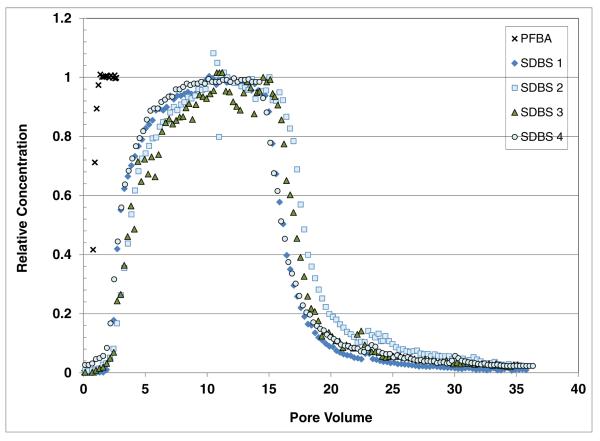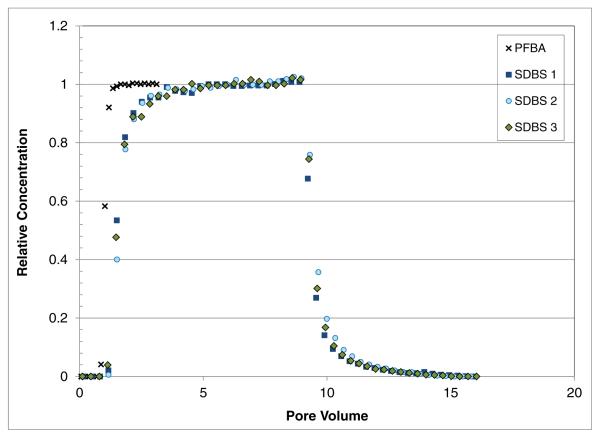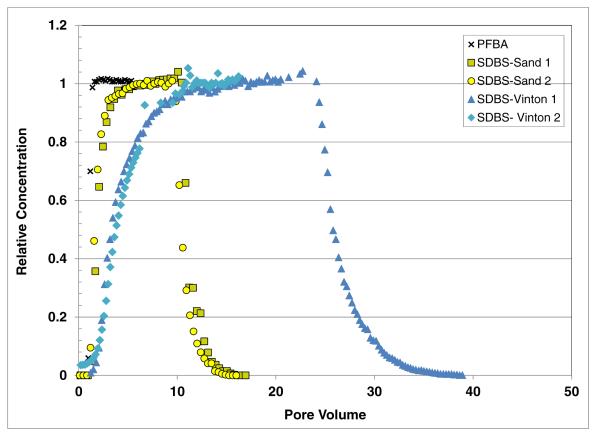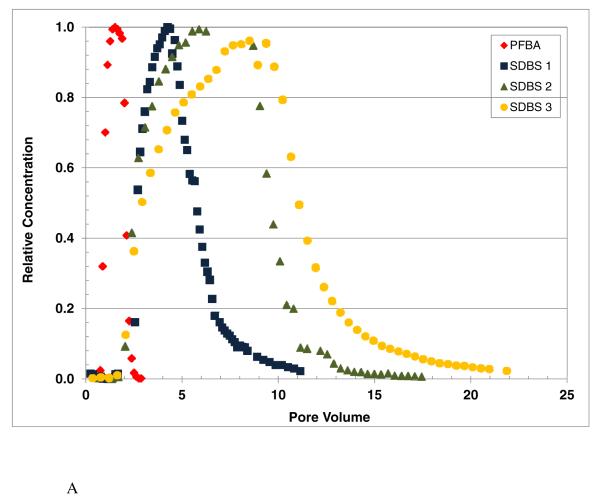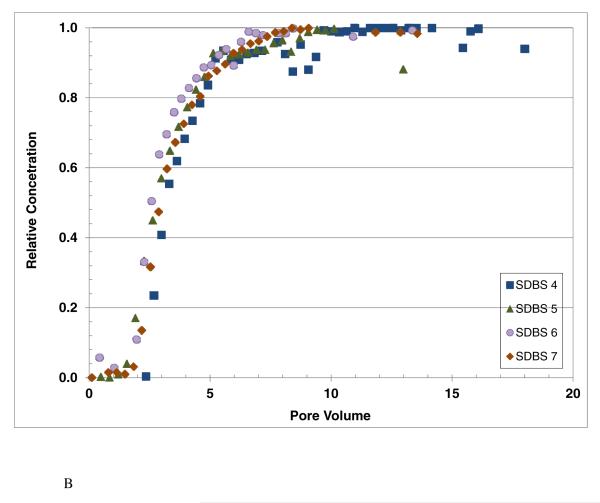Abstract
Interfacial partitioning tracer tests (IPTT) are used to measure air-water interfacial area for unsaturated porous media. The standard IPTT method involves conducting tests wherein an aqueous surfactant solution is introduced into a packed column under unsaturated flow conditions. Surfactant-induced drainage has been observed to occur for this method in some cases, which can complicate data analysis and impart uncertainty to the measured values. Two novel alternative approaches for conducting IPTTs are presented herein that are designed in part to prevent surfactant-induced drainage. The two methods are termed the dual-surfactant IPTT (IPTT-DS) and the residual-air IPTT (IPTT-RA). The two methods were used to measure air-water interfacial areas for two natural porous media. System monitoring during the tests revealed no measurable surfactant-induced drainage. The measured interfacial areas compared well to those obtained with the standard IPTT method conducted in such a manner that surfactant-induced drainage was prevented.
Keywords: air-water interface, tracer test, fluid-fluid interface
Introduction
The air-water interface plays a fundamental role in the distribution and transport of water and contaminants in unsaturated porous media. Understanding the influence of physicochemical properties and conditions on interfacial area is critical to accurate representations of multiphase flow and contaminant transport. Concomitantly, measuring and predicting air-water interfacial area for natural porous media has garnered great interest in the past two decades. Interfacial partitioning tracer tests (IPTT) are one of the few methods available for measuring air-water interfacial area (e.g., Karkare and Fort, 1996; Brusseau et al., 1997, Kim et al., 1997; Saripalli et al., 1997; Kim et al., 1999; Anwar et al., 2000; Schaefer et al., 2000; Costanza-Robinson and Brusseau, 2002; Peng and Brusseau, 2005; Brusseau et al., 2006; Chen and Kibbey, 2006; Brusseau et al., 2007; Costanza-Robinson et al., 2012).
The standard IPTT method involves conducting miscible-displacement tests wherein an aqueous tracer solution is introduced into a packed column under unsaturated flow conditions. The concentrations of the tracers in the column effluent are monitored to construct breakthrough curves, which are used to determine the retardation of the tracer that partitions to the interface relative to that of a non-reactive (non-partitioning) tracer. The magnitude of the retardation corresponds to the magnitude of the interfacial area. A surfactant is typically used as the partitioning tracer. One potential issue associated with the use of surfactant solutions is the well-known phenomenon of induced drainage related to the reduction in interfacial tension caused by the surfactant (e.g., Karkare and Fort, 1993; Henry and Smith, 2003). Surfactant-induced drainage can complicate data analysis and impart uncertainty to the measured interfacial areas. Conflicting results have been reported regarding the observation of surfactant-induced drainage for IPTT applications. Such drainage did not occur for some tests (Brusseau et al., 2007), but was observed for other tests (Chen and Kibbey, 2006; Costanza-Robinson et al., 2012). This difference in results is likely due to variations in the specific techniques used to implement the IPTT. For example, the apparatus used by Brusseau et al. (2007) employed a vacuum chamber system that maintains strong steady flow conditions, which minimizes the impact of changes in interfacial tension caused by introduction of the surfactant solution. Conversely, the apparatuses used in other IPTT applications may have been more susceptible to the impacts of changes in interfacial tension, and thus surfactant-induced drainage was observed.
The objective of this research is to present two novel alternative approaches for conducting IPTTs that are designed in part to prevent surfactant-induced drainage. The first alternative, termed the dual-surfactant IPTT (IPTT-DS) method, is based on using a two-surfactant system. In this case, one surfactant is used as the partitioning tracer, with its attendant breakthrough curve used to determine retardation, similarly to the standard IPTT method. In addition, a second, different surfactant is added to the aqueous solution that serves as the background solution for the miscible-displacement tests. Note that the background solution is devoid of surfactant for the standard IPTT method. Hence, the addition of the second surfactant to the background solution eliminates the condition present in the standard IPTT wherein there is an abrupt change in solution chemistry (and associated change in interfacial tension). The two surfactants and their respective concentrations are selected to ensure similar interfacial-tension reductions, which minimizes the potential to develop gradients in interfacial tension (and thus minimizing drainage).
The second novel method, termed the residual-air IPTT (IPTT-RA) method, is based on developing a fluid distribution within the column such that the air exists as a trapped, disconnected phase (i.e., “residual” saturation). The potential for drainage effects to occur is ameliorated under such conditions. In addition, this tracer test can be conducted similarly to a saturated-flow experiment, which significantly reduces the required experiment time. This approach is similar to the standard IPTT met hod used to measure interfacial area between organic liquids and water (e.g., Saripalli et al., 1997; Cho and Annable, 2005; Dobson et al., 2006; Brusseau et al., 2008; Brusseau et al., 2010; Narter and Brusseau, 2010), but has to date not been used to measure air-water interfacial area. Experiments are conducted with the two novel approaches to measure air-water interfacial areas for two natural porous media. The results are compared to those obtained with the standard IPTT method for which a specific technique was used to prevent surfactant-induced drainage.
2. Materials and Methods
2.1. Materials
Two porous media were used in this study. Vinton soil (sandy, mixed thermic Typic Torrifluvent), collected locally in Tucson, AZ., and a 45/50 mesh quartz sand (Accusand). Vinton soil was sieved to remove the fraction larger than 2 mm. Relevant properties of the porous media are presented in Table 1.
Table 1.
Relevant physical properties of the porous media
| Medium | Median diameter (mm) |
Uniformity coefficient Ua |
Bulk density ρb (g/cm3) |
Porosity n |
Ksat (cm/min) |
|---|---|---|---|---|---|
| Vinton | 0.23 | 2.4 | 1.50 | 0.376 | 0.2 |
| Sand | 0.35 | 1.1 | 1.65 | 0.326 | 1.3 |
U = (d60/d10).
Sodium dodecyl benzene sulfonate (SDBS, 35 mg/L) was used as the air-water interfacial partitioning tracer. Pentafluorobenzoic acid (PFBA, 100 mg/L) was used as the nonreactive tracer. Sodium chloride (0.01 M) was used as the background electrolyte solution to maintain a constant ionic strength, thus minimizing potential changes in electrostatic properties of the system. Sodium dodecyl sulfate (SDS, 65 mg/L) was used to create the background surfactant solution for the dual-surfactant tests. The interfacial partition coefficients (Ki), determined by measuring the interfacial tension functions, are 2.9 · 10−3 cm and 3.1 · 10−3 cm for SDBS and SDS, respectively, for the concentrations employed. Sorption of SDBS by the sand was minimal (Kd = 0.05 cm3/g) and greater for the soil (Kd = 0.5 cm3/g). SDS sorption by the soil was slightly larger than that of SDBS.
The column used for the standard IPTT and IPTT-DS tests was constructed of stainless steel and was 15 cm long by 2.2 cm in diameter. The column used for the IPTT-RA tests was constructed of glass and was 15 cm long by 2.5 cm in diameter. A porous frit was placed at the ends of the column to retain the media and to promote uniform water injection. The columns were packed with air-dried media to obtain uniform bulk densities. The columns were oriented vertically for all experiments.
2.2. Methods
Standard IPTT Method
The tracer tests for the standard IPTT technique were conducted after steady-state unsaturated flow was established at the desired water content. Tests were conducted for both primary drainage and primary imbibition conditions. For tests conducted under drainage conditions, the packed column was first completely saturated with electrolyte solution devoid of surfactant. Once saturated, the top cap of the column was removed to initiate drainage. A HPLC pump was used to provide a constant solution flow (0.5 ml/min, equivalent to a mean pore-water velocity of ~0.5 cm/min) to the exposed top of the column. Tubing connected to the bottom of the column was connected to a vacuum chamber that housed a fraction collector to which the column effluent line was connected for sample collection. The tracer solution was injected once steady flow was established. After the selected volume of tracer solution was injected, electrolyte solution was again injected to elute the tracer. The tests for imbibition conditions were conducted similarly, with the exception that the column was not saturated first.
The samples were weighed, providing a means of monitoring for potential variations in the amount of solution exiting the column, and determination of any changes in water saturation. The mass of the column was also directly measured periodically as a second determination of changes in water saturation. A PFBA tracer test was performed before each SDBS injection to characterize hydrodynamic properties of the column. Each set of tracer tests was conducted in a newly prepared column. In addition, partitioning tracer tests were conducted under water-saturated conditions to measure the adsorption of SDBS by the solid matrix.
IPTT-DS Method
The tracer tests for the dual-surfactant method were conducted similarly to those for the standard method, with two exceptions. One difference was the addition of SDS to the electrolyte solution. Preliminary tests were conducted to measure the interfacial-tension functions for both SDBS and SDS, and the associated Kia values. In addition, miscible-displacement experiments were conducted to measure the adsorption of SDS by the two media, as well as the adsorption of SDBS in the presence of SDS.. This information was used in conjunction with equation 1 to calculate expected retardation factors for both SDBS and SDS for a given water saturation. The retardation factors calculated for SDBS and SDS were 4.2 and 4.3, respectively, for Vinton soil and 2.0 and 2.1, respectively, for the sand. Because the calculated retardation factors for SDS and SDBS are similar, it was anticipated that the two tracers would have similar magnitudes of retention and transport, which would minimize the formation of gradients in interfacial tension within the column.
The other difference was the use of the vacuum-chamber system. For the IPTT-DS tests, one set was conducted with use of the vacuum-chamber system. This allowed direct comparison to the standard IPTT tests to evaluate the impact of the presence of the second surfactant. A second set of tests was then conducted without use of the vacuum-chamber system. In this case, the hanging water column technique was used to induce flow. It was demonstrated in a preliminary set of tests that significant surfactant-induced drainage occurred for tests conducted without the vacuum-chamber system. Specifically, water saturation decreased by 15% for Vinton soil and 46% for the sand upon introduction of the surfactant solution. This degree of surfactant-induced drainage is consistent with that reported in prior studies (Costanza-Robinson et al., 2012). Thus, the IPTT-DS tests conducted without the vacuum-chamber system provide the opportunity to evaluate the ability of the method to prevent surfactant-induced drainage.
IPTT-RA Method
These tracer tests were conducted using the general approach presented by Brusseau et al. (2008) for measuring organic-liquid/water interfacial area, modified for the air-water system. Two sets of tests were conducted with the Vinton soil (no tests were conducted for the sand), with 3 tests conducted under secondary imbibition and 4 tests conducted under primary imbibition conditions. Three different water saturations were represented among the total of 7 tests (0.8, 0.9, and 0.95). For the first set, the electrolyte solution was injected into the bottom of the packed column at a low flow rate (Q =0.01 ml/min) for approximately 72 hours to ensure full saturation. Once saturation was achieved, the column was drained from the bottom, with the top open to the atmosphere. The column was then recapped, and several pore volumes of electrolyte solution was injected into the top of the column at Q=~0.6 ml/min (equivalent to a mean pore-water velocity of ~0.3 cm/min) to trap air at residual saturation. The electrolyte solution was then injected at Q=0.01 ml/min for 48 hours to ensure stable conditions. The tracer tests (PFBA followed by SDBS) were then conducted. For the second set of tests, the background electrolyte solution was injected at a high flow rate into the top of the dry packed column to trap air. The tracer test was initiated after several pore volumes of conditioning.
For all tests, the porous medium was extruded from the column into five sections after the test. The mass of each sample was recorded before and after they were placed in an oven for at least 48 hours. These measurements were used to determine the magnitude and variability of water saturation in the column.
2.3. Chemical and Data Analysis
Concentrations of PFBA and SDBS were measured using a UV-Vis Spectrophotometer (Shimadzu model 1601). SDS concentrations, in the absence of SDBS (e.g., background tracer tests), were measured by determining interfacial tension of the samples. The interfacial tension was measured with a Surface Tensiomat (Fisher Scientific, model 21) using the ring method. The ring method determines the force required to detach the wire loop (i.e., ring) from the surface of a liquid.
The breakthrough curves obtained from the tests were analyzed using moment analysis and/or area-above-the-curve analysis to determine the Retardation Factors (R) for tracer retention during transport. The air-water interfacial area (Aia) is calculated using this value in conjunction with equation 1:
| (1) |
where Kd (cm3/g) is the sorption coefficient for adsorption by the solid surface, ρb(g/cm3) is the bulk density, θw is the volumetric water content, and Aia(cm−1) is the specific air-water interfacial area, which is interfacial area normalized by the porous-medium volume. Water saturation (Sw) is defined as θw/n, where n is porosity. Nonwetting-phase (air) saturation, Sn, is defined similarly.
3. Results and Discussion
3.1 Standard IPTT Method
The breakthrough curves for PFBA, the nonreactive tracer, exhibited ideal transport for all experiments (see Figures 1 and 2). SDBS transport was retarded compared to that of PFBA for both porous media. This retardation was due to the combination of sorption by the solid phase and accumulation at the air-water interface. The sorption component was accounted for in the calculation of interfacial area using equation 1.
1.
Tracer breakthrough curves for PFBA and SDBS transport in Vinton soil for the standard IPTT method. Tests SDBS 1-3 were conducted under primary drainage, while test SDBS 4 was conducted under primary imbibition.
2.
Tracer breakthrough curves for PFBA and SDBS transport in the sand for the standard IPTT method. Tests SDBS 1 and 2 were conducted under primary drainage, while test SDBS 3 was conducted under primary imbibition.
Three replicate tests were conducted with the standard IPTT method for Vinton soil under primary drainage conditions. The mean water saturation for these tests was 0.82, with a coefficient of variation (COV) of 0.6%. The R values for SDBS ranged from 4.0 to 4.5, with a mean of 4.3 and a COV of 6%. The mean specific air-water interfacial area was 68 cm−1, with a COV of 9%. The air-water interfacial area was 61 cm−1 for the single test conducted under primary imbibition conditions, with a water saturation of 0.80. The interfacial area measured under imbibition conditions is slightly smaller than those obtained under drainage conditions. However, the observed difference is within the range of uncertainty. Similar results were reported in a prior study (Brusseau et al., 2007).
Three tests were conducted with the standard IPTT method for the sand, with two under drainage and one under imbibition conditions (see Figure 2). The mean water saturation was 0.81, with a coefficient of variation (COV) of 1%. The mean R value for SDBS was 1.7 (COV = 2%), and the mean specific air-water interfacial area was 41 cm−1 (COV = 8%). The small COV values observed for water saturation and interfacial area for both porous media indicate that the tests displayed very good precision and reproducibility.
Continuous monitoring revealed that water saturation within the columns varied by 1% or less for all experiments, a value well within measurement uncertainty. This indicates that no surfactant-induced drainage occurred for the tracer tests conducted using the standard IPTT method when the vacuum-chamber system was employed. This is consistent with prior results reported by Brusseau et al (2007), for which the vacuum-chamber system was also employed.
3.2 Dual-surfactant IPTT Method
Four tests were conducted with the IPTT-DS method under drainage conditions, two for Vinton soil and two for the sand (Figure 3). Continuous monitoring of the system revealed no measurable change in water saturation during any of the IPTT-DS tests, including the two tests conducted with the hanging water column technique (no vacuum-chamber system). This indicates that no measurable surfactant-induced drainage occurred in the absence of the vacuum-chamber system. This is in contrast to the results of the preliminary tests discussed above for which significant surfactant-induced drainage was observed when the standard IPTT tests were conducted without the vacuum-chamber system. These results indicate that the IPTT-DS method was successful in preventing surfactant-induced drainage. As noted above, the similarity of R values between SDBS and SDS means that there would be minimal separation of the respective tracer fronts during the miscible-displacement process. Thus, there would be minimal formation of a gradient in interfacial tension, and therefore surfactant-induced drainage would be expected to be minimal as was observed.
3.
Tracer breakthrough curves for PFBA and SDBS transport in Vinton soil and sand for the IPTT-DS method.
For the Vinton soil, an interfacial area of 57 cm−1 (Sw = 0.8) was obtained for the IPTT-DS test conducted with the vacuum-chamber system. This value is within the 95% confidence interval range of the values measured for Vinton soil with the standard IPTT method, 68 (56-80) cm−1. This indicates that the presence of the second surfactant had no measurable impact on the test results. An interfacial area of 52 cm−1 (Sw = 0.9) was obtained for the test conducted without the use of the system. This value is somewhat lower than the standard-method range, but a smaller interfacial area is expected for the higher Sw.
For the sand, an interfacial area of 48 cm−1 (Sw = 0.75) was obtained for the IPTT-DS test conducted with the vacuum-chamber system. This value is within the 95% confidence interval range of the values measured for the sand with the standard IPTT method, 41 (34-48) cm−1. Similar to the Vinton tests, this indicates that the presence of the second surfactant had no measurable impact on the test results. An interfacial area of 68 cm−1 (Sw = 0.72) was obtained for the test conducted without the use of the system. This value is larger than the range obtained with the standard IPTT method, but a larger interfacial area is expected given the substantially lower water saturation associated with this IPTT-DS test.
3.3 Residual-air IPTT Method
Seven tracer tests were conducted with the IPTT-RA method for Vinton soil, four under primary imbibition and three under secondary imbibition conditions. The breakthrough curves for the two sets of tests are presented in Figure 4. No evidence of surfactant-induced drainage was observed for these tests. This is consistent with the results reported by Brusseau et al. (2008), who used x-ray microtomography to directly examine the impact of SDBS solutions on fluid distribution and interfacial area for an organic-liquid/water system. No significant changes in the morphology or distribution of the organic liquid, which was present at residual saturation, were evident with addition of an SDBS solution. Furthermore, the interfacial area changed by less than 5% after introduction of the SDBS solution. These results indicate that surfactant-induced drainage and related effects are minimal for the IPTT-RA method.
4.
Tracer breakthrough curves for PFBA and SDBS transport in Vinton soil for the IPTT-RA method: A. secondary imbibition conditions (the tests represent three different water saturations); B. primary imbibition conditions (the tests represent two different sets of water saturations).
There was no significant difference in the mean interfacial areas obtained for the tests conducted under primary versus secondary imbibition. This suggests that there was no measurable impact of imbibition conditions. A mean interfacial area of 61 cm−1 (COV = 64%) was obtained for three tests conducted with a mean water saturation of 0.81 (COV = 5%). This value is very similar to the interfacial area obtained with the standard IPTT test. A mean interfacial area of 33 cm−1 (COV = 43%) was obtained for three tests conducted with a mean water saturation of 0.89 (COV = 1%).
It is observed that the COV values for the interfacial areas measured with the IPTT-RA method are considerably greater than those associated with the standard IPTT method. Similar relatively large degrees of uncertainty were observed for measurements of organic-liquid/water interfacial areas using the related IPTT method (Dobson et al., 2006; Brusseau et al., 2008). A detailed discussion of potential sources of uncertainty for the IPTT method was presented by Brusseau et al. (2008). For the present study, the experiments were designed and conducted to ensure that basic conditions were as similar as possible amongst the various tests. For example, the column lengths and pore-water velocities were similar. Thus, residence times were similar for all tracer tests, thereby minimizing potential effects of differentials in residence times on transport and mass-transfer processes. The similar-sized columns and similar water saturations between tests means that nonwetting-phase volumes were similar, as were REV scales. In addition, the drainage/imbibition status appears to have had no significant impact, given that the interfacial areas obtained for the standard IPTT method under primary drainage and primary imbibition are similar, and that those values are similar to the interfacial areas obtained with the IPTT-RA method for both primary and secondary imbibition. One possible factor may be that the configuration of the nonwetting phase may be less variable from test to test for the standard method compared to the IPTT-RA method, given that a vacuum-chamber system is used for the former tests.
4. Conclusion
Two novel alternative approaches for conducting IPTTs to measure air-water interfacial area were presented herein that are designed in part to prevent surfactant-induced drainage such as has been observed in some prior reports. No measurable surfactant-induced drainage occurred for the tracer tests conducted herein using the standard IPTT method, likely due to the use of a vacuum-chamber system. Furthermore, no measurable surfactant-induced drainage occurred for the tracer tests conducted using the two alternative methods.
The results of our experiments show that the two alternative methods provided reasonably similar measurements of air-water interfacial area compared to the standard IPTT method. In addition, the interfacial areas measured under imbibition conditions were similar to those measured under drainage conditions for the standard method. This suggests that the measurements obtained with the IPTT-RA method, which represent imbibition conditions, can be considered to be comparable to those obtained with the other methods under drainage conditions. The alternative methods have promise for situations wherein the standard IPTT method, with strong vacuum control, cannot be implemented.
The IPTT-DS method is conducted similarly to that of the standard IPTT method, and is anticipated to have similar robust precision and reproducibility. A disadvantage of the standard and IPTT-DS methods is that several days are required to complete a test. An advantage of the IPTT-RA method is that a much simpler apparatus can be used, and the experiments can be completed in a significantly shorter time compared to the other two methods. However, greater uncertainty in measured interfacial area was observed for this method. Thus, conducting replicated measurements is especially important for this method. Another limitation of the IPTT-RA method is the narrower range of water saturations that can be obtained compared to the standard IPTT method.
Highlights.
Interfacial partitioning tracer tests (IPTT) are used to measure air-water interfacial area
Two novel alternative approaches for conducting IPTTs are presented
System monitoring during the tests revealed no measurable surfactant-induced drainage
The measured interfacial areas compared well to those obtained with the standard IPTT method
Acknowledgments
This research was funded by the NIEHS Superfund Basic Research Program (Grant # E504940). We thank the reviewers for their constructive comments.
Footnotes
Publisher's Disclaimer: This is a PDF file of an unedited manuscript that has been accepted for publication. As a service to our customers we are providing this early version of the manuscript. The manuscript will undergo copyediting, typesetting, and review of the resulting proof before it is published in its final citable form. Please note that during the production process errors may be discovered which could affect the content, and all legal disclaimers that apply to the journal pertain.
References
- Anwar A, Bettahar M, Matsubayashi UJ. A method for determining air–water interfacial area in variably saturated porous media. J. Contam. Hydrol. 2000;43:129–146. [Google Scholar]
- Brusseau ML, Popovicova J, Silva JAK. Characterizing gas-water interfacial and bulk-water partitioning for gas-phase transport of organic contaminants in unsaturated porous media. Environ. Sci. Technol. 1997;31:645–1649. [Google Scholar]
- Brusseau ML, Peng S, Schnaar G, Costanza-Robinson MS. Relationships among air-water interfacial area, capillary pressure, and water saturation for a sandy porous medium. Water Resour. Res. 2006;42:W03501. [Google Scholar]
- Brusseau ML, Peng S, Schnaar G, Murao A. Measuring air-water interfacial areas with x-ray microtomography and interfacial partitioning tracer tests. Environ. Sci. Technol. 2007;41:1956–1961. doi: 10.1021/es061474m. [DOI] [PubMed] [Google Scholar]
- Brusseau ML, Narter N, Janousek H. Interfacial partitioning tracer test measurements of organic-liquid/water interfacial areas: Application to soils and the influence of surface roughness. Environ. Sci. Technol. 2010;44:7596–7600. doi: 10.1021/es101312n. [DOI] [PMC free article] [PubMed] [Google Scholar]
- Brusseau ML, Narter M, Schnaar S, Marble J. Measurement and estimation of organic liquid/water interfacial areas for several natural porous media, Environ. Sci. Technol. 2009;43:3619–3625. doi: 10.1021/es8020827. [DOI] [PMC free article] [PubMed] [Google Scholar]
- Chen L, Kibbey TCG. Measurement of air–water interfacial area for multiple hysteretic drainage curves in an unsaturated fine sand. Langmuir. 2006;22(16):6874–6880. doi: 10.1021/la053521e. [DOI] [PubMed] [Google Scholar]
- Costanza-Robinson MS, Brusseau ML. Air-water interfacial areas in unsaturated soils: Evaluation of interfacial domain. Water Resour. Res. 2002;38(10):13–1. [Google Scholar]
- Costanza-Robinson MS, Zheng Z, Henry E,J, Benjamin D, Estabrook, Littlefield MH. Implications of surfactant-induced flow for miscible-displacement estimation of air–water interfacial areas in unsaturated porous media. Environ. Sci. Technol. 2012 doi: 10.1021/es303003v. dx.doi.org/10.1021/es303003v. [DOI] [PubMed] [Google Scholar]
- Cho J, Annable MD. Characterization of pore scale NAPL morphology in homogeneous sands as a function of grain size and NAPL distribution. Chemosphere. 2005;61:899–908. doi: 10.1016/j.chemosphere.2005.04.042. [DOI] [PubMed] [Google Scholar]
- Dobson R, Schroth MH, Oostrom M, Zeyer J. Determination of NAPL-water interfacial areas in well-characterized porous media. Environ. Sci. Technol. 2006;40:815–822. doi: 10.1021/es050037p. [DOI] [PubMed] [Google Scholar]
- Fisher-Scientific . Fisher Surface Tensiomat Model 21. Fisher Scientific; Dubuque, Iowa: 2006. [Google Scholar]
- Henry EJ, Smith JE. Surfactant-induced flow phenomena in the vadose zone. A review of data and numerical modeling. Vadose Zone J. 2003;2(2):154–167. [Google Scholar]
- Karkare MV, Fort T. Criteria for effectiveness of surfactants as water-moving agents in “unsaturated” wet sand. Langmuir. 1993;9:1684–1690. [Google Scholar]
- Karkare MV, Fort T. Determination of the air-water interfacial area in wet “unsaturated” porous media. Langmuir. 1996;12:2041–4044. [Google Scholar]
- Kim H, Rao PSC, Annable MD. Determination of effective air-water interfacial area in partially saturated porous media using surfactant adsorption. Water Resour. Res. 1997;33(12):2705–2711. [Google Scholar]
- Kim H, Rao PSC, Annable MD. Gaseous tracer technique for estimating air-water interfacial areas and interface mobility, Soil Sci. Soc. Am. J. 1999;63:1554–1560. [Google Scholar]
- Narter M, Brusseau ML. Comparison of interfacial partitioning tracer test and high-resolution microtomography measurements of fluid-fluid interfacial areas for an ideal porous medium. Water Resour. Res. 2010;46:W08602. doi: 10.1029/2009WR008375. [DOI] [PMC free article] [PubMed] [Google Scholar]
- Peng S, Brusseau ML. The impact of soil texture on air-water interfacial areas in unsaturated sandy porous media. Water Resour. Res. 2005;41:W03021. doi:10.1029/2004WR003233. [Google Scholar]
- Saripalli KP, Kim H, Rao PSC, Annable MD. Measurement of specific fluid-fluid interfacial areas of immiscible fluids in porous media. Environ. Sci. Technol. 1997;31(3):932–936. [Google Scholar]
- Schaefer CE, DiCarlo DA, Blunt MJ. Experimental measurement of air–water interfacial area during gravity drainage and secondary imbibition in porous media. Water Resour. Res. 2000;36:885–890. [Google Scholar]



